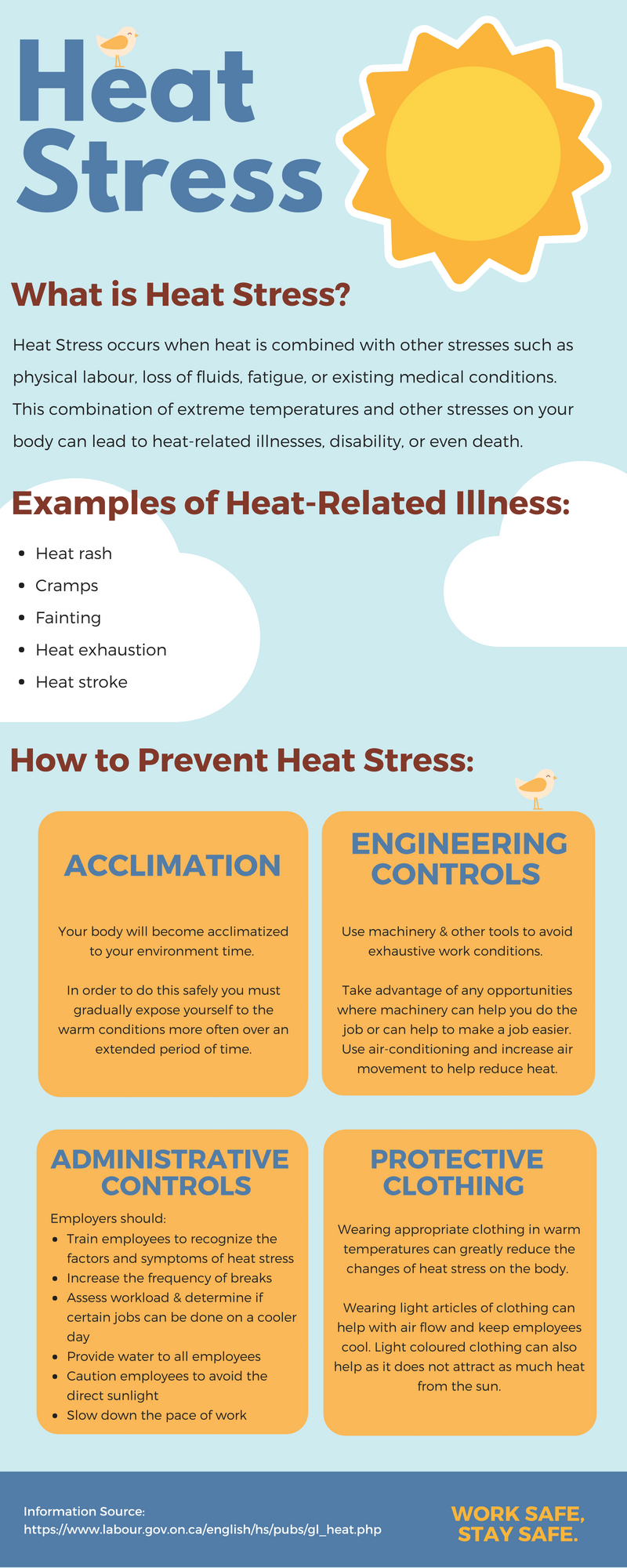Summer is rapidly approaching and we’ve already felt some of the heat so far this spring. During the warmer months there are new hazards in the workplace that we must be aware of. This weather seems nice but brings new heat-related dangers for workers, the biggest of which is Heat Stress.
Preventing Heat Stress
View our infographic or read the text description below for everything you need to know about Heat Stress and how to prevent this hazard in the coming summer months.
What is Heat Stress?
Heat Stress occurs when heat is combined with other stresses such as physical labour, loss of fluids, fatigue, or existing medical conditions. This combination of extreme temperatures and other stresses on your body can lead to heat-related illnesses, disability, or even death.
Heat-Related Illnesses
Some examples of the illnesses that can occur are:
- heat rash
- cramps
- fainting
- heat exhaustion
- heat stroke
For more information on each of these illnesses including causes, symptoms, treatments, and preventions please visit the Ministry of Health guideline here.
How to Prevent Heat Stress
According to the Ministry of Health there are four ways to control Heat Stress:
1. Acclimation – The longer you work in a hot environment the easier it will be on your body. You will become acclimatized to the environment over a period of time. In order to do this safely you must gradually expose yourself to the warm conditions more often over an extended period of time.
2. Engineering Controls – Using machinery and other tools to avoid exhaustive work conditions. This means taking advantage of any cases where machinery can help you do the job or can help to make a job easier. Using air-conditioning, increasing air movement, and providing workers with cool and shaded rest areas will also help to reduce the chances of heat stress.
3. Administrative & Work Practice Controls – Employers play a large role in managing heat stress in the workplace. Employers should: train employees to recognize the factors and symptoms of heat stress, increase the frequency of breaks, assess the workload and determine if certain jobs can be done on a cooler day, provide water to all employees, caution employees to avoid the direct sunlight, and slow down the pace of work.
4. Protective Clothing – Wearing appropriate clothing in warm temperatures can greatly reduce the changes of heat stress on the body. Wearing light articles of clothing can help with air flow and keep employees cool. Light coloured clothing can also help as it does not attract as much heat from the sun.
Heat Stress is entirely preventable as long as we are aware of our working conditions and our limitations. Keep yourself and your co-workers safe this summer by following the preventative tips above!
Information Source: https://www.labour.gov.on.ca/english/hs/pubs/gl_hear.php
Work Safe. Stay Safe.

